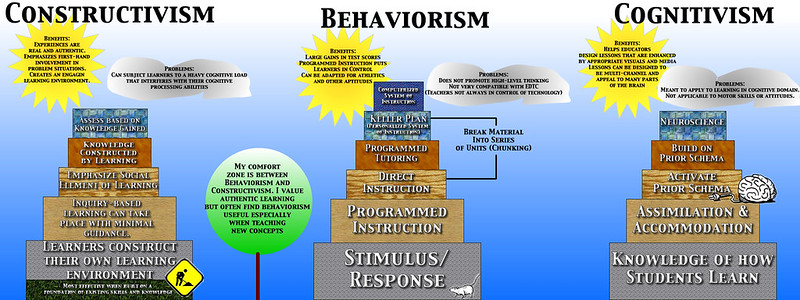The key difference between constructivism and cognitivism is that constructivism explains that learners use prior knowledge to understand new knowledge, while cognitivism explains that learning takes place through the internal processing of information. Constructivism and cognitivism are two learning theories popular in education. Many educators use these theories to deliver an effective teaching experience to their students.
Key Takeaways
- Constructivism is based on the idea that knowledge is constructed by learners from their prior knowledge and experience, and it includes principles such as active learning and the importance of social interaction.
- Cognitivism focuses on processes of the mind and how the learner’s mind makes connections between external factors and internal knowledge, with strategies such as anticipation guides, concept maps, and reflection questions.
- The key difference between constructivism and cognitivism is that constructivism refers to how learners learn, using prior knowledge to understand new information, whereas cognitivism explains that learning occurs through the internal processing of information.
What is Constructivism?
Constructivism is considered a part of the Cognitive Developmental Theory of Learning. Constructivism is based on the idea that knowledge is constructed by learners from their prior knowledge and experience. Many educators have adapted constructivism to help their students in learning. In constructivism, learners use their previous knowledge and build new things from what they learn.
There are different principles of constructivism. Knowledge is constructed, and it is built on previous knowledge. Thus, students’ previous knowledge, experience, and beliefs are important in the continuation of the learning. At the same time, learning is an active process. In order to understand the process of learning, learners have to engage in activities such as discussions and group activities. Hence, active learning takes place in this process.
Another specific principle in constructivism is that learning is a social activity. Isolated learning is not successful, and progressive education recognizes that social interaction is one main way of learning. Thus, educators help students with the conversation, interaction, and group application to retain knowledge. There are different types of constructivism as cognitive constructivism, social constructivism, and radical constructivism. The main drawback of constructivism is its lack of structure.
What is Cognitivism?
Cognitivism is a theory that focuses on processes of the mind. According to cognitivist theory, the way someone learns is determined by the way that person’s mind takes in things. The basis of cognitivism is that when students are learning a new thing, the prior knowledge always makes a connection with new knowledge.
The mind always tries to make a connection between external factors the internal knowledge. There are cognitive learning strategies that are used by educators to provide an effective learning environment for learners. Educators use different strategies in the beginning, middle, and conclusion of a learning process. Thus, it helps to make connections in the brains of the learners. One best example of cognitivism is solving problems using prior knowledge. Beginning strategies include anticipation guides, and middle strategies include concept maps, sorting activities, and note-taking, whereas ending strategies include reflection questions and compare and contrast.
What is the Difference Between Constructivism and Cognitivism?
The key difference between constructivism and cognitivism is that constructivism explains that learners use prior knowledge to understand new knowledge, while cognitivism explains that learning takes place through the internal processing of information. Moreover, although the learner is an active participant in the construction of knowledge in both constructivism and cognitivism, the teacher or the instructor plays different roles in these two learning theories. The instructor facilitates an active learning environment with a constructive approach, whereas the instructor creates an environment where thinking activities and processes take place in cognitivism.
Furthermore, strategies like interactive group activities are used in constructive theory, while sorting activities and note-taking activities are more used in cognitivism. Also, in constructive theory, learners use their previous knowledge to understand, whereas, in cognitivism, the learner’s mind always tries to make connections with external factors and internal knowledge. In addition, there are different principles in constructivism, but there are no specific principles for cognitivism.
Summary – Constructivism vs Cognitivism
The key difference between constructivism and cognitivism is that constructivism refers to how learners learn and explains that learners construct new knowledge based on their prior knowledge in understanding, whereas cognitivism explains that learning occurs through the internal processing of information.
Reference:
1. “What Is Constructivism?” Western Governors University, 21 Oct. 2020.
2. Michela, Esther. “Cognitivism.” EdTech Books, 1 Jan. 1970.
Image Courtesy:1. “Classroom setting” By CommunicationsTCS – Own work (CC BY-SA 4.0) via Commons Wikimedia
2. “Learning theories” By Mikel Agirregabiria (CC BY-NC-SA 2.0) via Flickr
